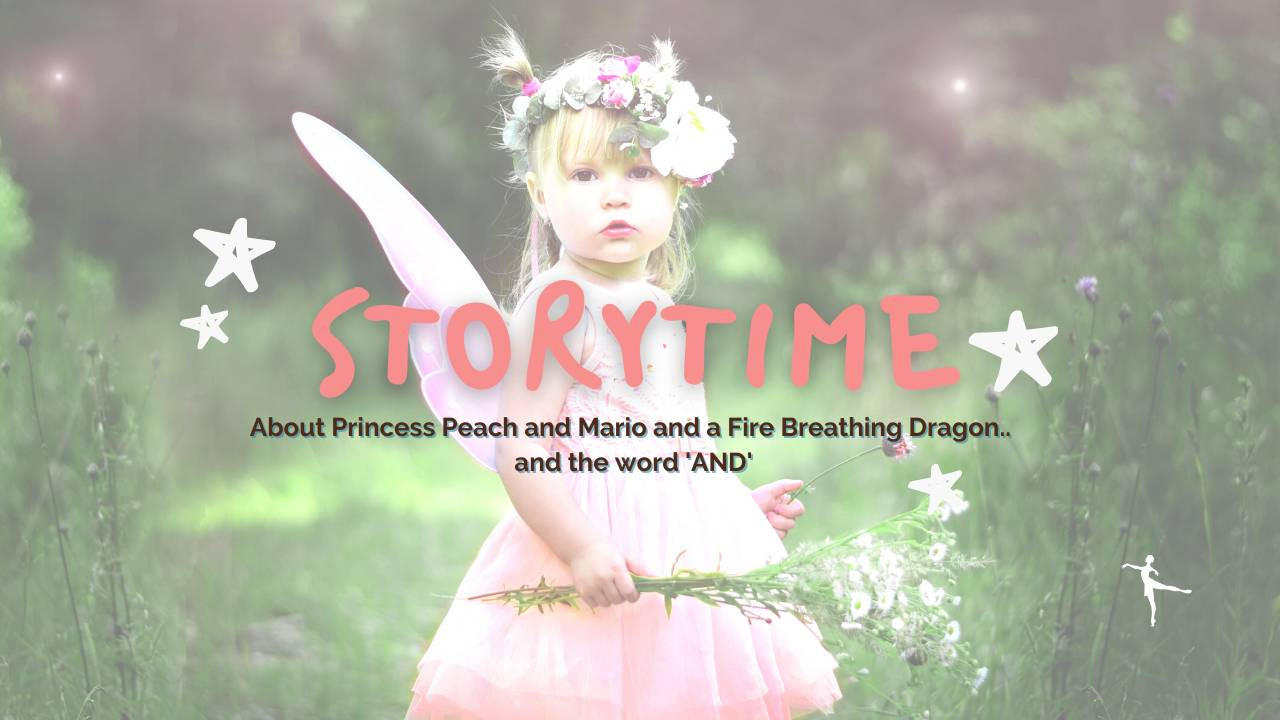
#31: Storytime and way too many 'and's!
Oct 13, 2020A Dragon and Mario and Princess Peach
Story by a 4 year old
Once upon a time there was a dragon and he was big and fast and breathed fire when he was angry and there was a princess named Princess Peach that lived in a castle who had a super power where she could become invisible and one day the dragon found her castle and wanted to eat her but just when he was ready to eat her, she disappeared and he was very angry and breathed fire and burned the water around the castle and then Mario came and ate mushroom power and got so big that he could just pick up the little dragon by his tail and so he picked him up and said you should leave the princess alone and then he threw the dragon far away into the ocean where his fire wouldn't hurt anyone and then the princess was ok and said Thank you Mario, and then Mario said You're welcome and then.. at which time we interrupt him and say it's bedtime!
How many 'and's are in that story? A TON right? To be precise, 18!
This is the kind of night time story I get if I let the 4 year old tell us his bedtime story instead of us telling him one. lol. It's fun but it's one gigantic run-on sentence filled with tons of 'and's! The story is awesome, but told by an adult with better sentence structure abilities, this story would have been told differently.
Get to the point Lorel!
Ok, ok! Enough stories, let me tell you where I'm going with this! As a dance accompanist, something that comes up sometimes is the over use of the word 'AND'.
Let me explain..
So, the 'and', or 'y', is a word or sound that every ballet teacher uses constantly in a ballet class! Today I'd like to explore that in a little closer detail.
Fine Tuning the 'Y' or 'AND'
1) The 'and', or 'y', functions as a meter indicator
If you the music want is 1 and 2 and 3 and 4 and, using the 'and' that way indicates to everyone in the room that you want something duple meter, either a 4 or a 2. Beautiful! It provides clarity for everyone!
If you count 1 and ah 2 and ah 3 and ah 4 and ah, then everyone knows your want something triple meter, likely a waltz or adagio 3.
*HEADS UP: If you are still learning about counting music and you mark something like this, &1 &2 &3 &4 you likely also want a 3, you might not have realized yet that the silence/breath between the count and the '&' is actually the 2nd beat in the music!
2) The 'AND' as a pattern/accent indicator
This is also super important!
What I run into sometimes are dance teachers that use the 'and' before every single dancer count. Always! And 1, and 2, etc.
This is absolutely awesome if your exercise is out on the 'and' and closed on the dancer count. Point close, hold, hold, out and-close, etc.
HOWEVER, if your exercise is about a position out (say tendu or degage/jete out) or a plie on the dancer count, you need to start with 1, not the 'AND'! 1 and 2 and, etc.
Give it a Try
Imagine an 8 count tendu exercise in your head that is out on the dancer count. Do you have one in your head? Perfect!
I want you to count it starting with the dancer count 1, Don't say the word 'and' until after dancer count 1 (don't worry about the introduction for now!).
That's a very different accent than a tendu that is out on the 'and'! Speaking of..
Now, keep your same tendu pattern but count it with the tendu out on the 'and' and closed on 1. 'And closed!' Do you hear the differences in the accents? & 1.
Musicians you work as well as your dancers will pick up those nuances in your speech/marking of your exercises! If you mark them clearly, everyone will be much more secure on what you want from the exercise before they've even begun the exercise! Win for you, right?!
Introductions
When you're marking introductions for your exercises, it is really ideal to integrate all of this detail work immediately! Everyone gets a good sense of your exercise IMMEDIATELY! For example:
(Speak this one like a slow waltz) 5 & a 6 & a 7 & a 8 & a Ten-du-point, clos-ing-in, press-ing-side, clos-ing-back, etc.
This is a totally different exercise than...
(speak it like a slow march) & 5 & 6 & 7 & 8 grande battment, stretch stretch, side and close, press stretch, back and touch, reach, reach up and cloch cloch cloch, reverse!
It started with a clear introduction that taught the musicality I wanted, IMMEDIATELY!
In Conclusion
Whether you pick your own music or a musician does, your students and your exercises will be so much more musical if you can keep your use of 'and's or 'y' to a very logical and intentionally chosen amount! No more run-on stories of 'and's; it's not necessary. These small, wonderful words, have very specific roles in the marking of exercises. Now you know the rest of the story.
If you enjoyed learning about music from this blog post and others, make sure you sign up to be on the wait list for my music training course! It only opens up a few times a year and you don't want to miss it!
Stay connected with news and updates!
Join our mailing list to receive the latest news and updates from our team.
Don't worry, your information will not be shared.
We hate SPAM. We will never sell your information, for any reason.

